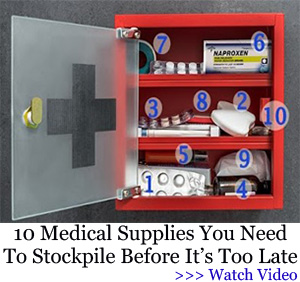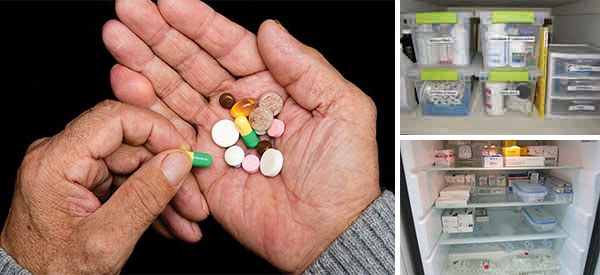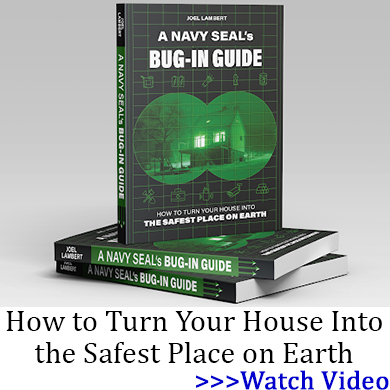Disclaimer: This article is for interest and information purposes only. We do not advocate for the use of medications outside of their formal licensing and hold no liability for the consequences of misuse of any information provided within this article.
In our recent article discussing the real expiration date of the drugs in your medicine cabinet, we established that storing drugs in line with the manufacturer’s recommendations is important, if we are to consider using the drugs past their printed expiration date. This article focuses on those recommendations and how to store medications to keep them in good condition for as long as possible.
What Are the Manufacturer’s Recommendations?
You will find below the printed storage recommendations for 15 commonly prescribed medications in the United States:
| Drug | Use | Storage Recommendations | Where to Store it? | ||
| Temp | Humidity | Light | |||
| Acetaminophen | Pain relief | 59 – 86°F
15 – 30°C |
Avoid | Avoid | Medicine box |
| Acetaminophen–hydrocodone | Pain relief | 68 – 77°F
20 – 25°C |
– | Avoid | Medicine box |
| Albuterol inhaler | Asthma treatment | 59 – 77°F
15 – 25°C |
Avoid | Avoid * | Medicine box |
| Amlodipine | Blood pressure (CCB) | 59 – 86°F
15 – 30°C |
Avoid | Avoid | Medicine box |
| Amoxicillin | Antibiotic | 59 – 86°F
15 – 30°C |
Avoid | Avoid | Medicine box |
| Atorvastatin | Cholesterol (statin) | 68 – 77°F
20 – 25°C |
Avoid | – | Medicine box |
| Chloramphenicol eye drops | Eye infections | 36 – 46°F
2 – 8°C |
– | – | Refrigerator |
| Chloramphenicol eye ointment | Eye infections | Below 77°F or 25°C | Avoid | Avoid | Medicine box |
| Gabapentin | Anti-epileptic and nerve pain | 68 – 77°F
20 – 25°C |
Avoid | – | Medicine box |
| Insulin | Diabetes | 36 – 46°F
2 – 8°C |
– | – | Refrigerator |
| Latanoprost eye drops | Glaucoma | 36 – 46°F
2 – 8°C |
– | – | Refrigerator ** |
| Levothyroxine | Hypothyroid treatment | 59 – 86°F
15 – 30°C |
Avoid | Avoid | Medicine box |
| Lisinopril | Blood pressure (ACE inhibitor) | 59 – 86°F
15 – 30°C |
Avoid | – | Medicine box |
| Losartan | Blood pressure (ARB) | 59 – 86°F
15 – 30°C |
Avoid | Avoid | Medicine box |
| Omeprazole | Stomach acid (PPI) | 59 – 86°F
15 – 30°C |
Avoid | Avoid | Medicine box |
*Inhaler canister can burst if temperature exceeds 120°F (49°C).
** Once opened, bottle can be stored at room temperature (up to 77°F or 25°C).
From this information, we can see that the manufacturer’s recommendations are almost always to keep medications away from humidity and direct light.
Humidity can damage the physical structure of the medication and cause the active ingredients to break down more quickly. Direct light can cause intense temperature changes, as well as causing some medications to degrade.
The temperature recommendations for different drugs vary, but can be broadly grouped into two categories: refrigerator and room temperature.
The Ideal Medicine Box
You can maintain a dark and dry environment for your medications using a sealed opaque box, and including a couple of sachets of silica gel to reduce humidity. The silica gel will need to be checked from time to time and replaced or refreshed, if it has changed color.
Many medications can be dangerous if taken accidentally by children or pets, so keeping your medicine box out of the reach and sight of children is very important. A lockable box also helps keep them safe from accidentally accessing your medications.
Drugs should also be kept in their original containers for storage, both to protect them and to ensure nobody mistakes them for different drugs at a later date. Your medicine box will need to be big enough to accommodate the bottles and packages of the medications you are storing.
Related: DIY Dollar Store First Aid Kit
How to Store Medications in the Refrigerator
There are specific drugs that need to be stored in the refrigerator, including medications such as insulin and eye drops. The need to be at a low temperature is sometimes related to keeping the drug sterile and avoiding bacterial contamination, and sometimes because of properties of the medication itself. Insulin, for example, is a protein and is at risk of degrading if it gets too warm.
Conversely, extremely low temperatures can also damage your medicine. Freezing can cause insulin to immediately lose its efficacy. So it is important that your drugs don’t come into contact with the cooling element at the back of your refrigerator, as this area can be colder than the rest of the refrigerator and can lead to freezing.
If you are using a sealed medicine box as discussed above, there should be no concern of contamination of your medication from food and other products in your fridge.
Related: Preparedness for People with Diabetes (part. 1 : How to Make Insulin)
How to Store Medications at Room Temperature
Most drugs need to be stored at “room temperature”, but the ranges for room temperature cited by different manufacturers are variable. Some have a broad range from 59 to 86°F (15 to 30°C), while others are much more restricted, ranging between 68 and 77°F (20 and 25°C).
In reality, the differences in the temperature ranges cited probably have more to do with the storage regimes implemented by the manufacturer, rather than genuine differences in drug stability. If the manufacturer’s own storage protocol maintains a temperature between 68 and 77°F, and the drug is proven safe and effective based on this regime, then those will be the recommendations applied to the drug storage on the license.
Nevertheless, if we wish to ensure our medications stay in good condition for as long as possible, we need to try to adhere to these recommendations, and ideally find somewhere that sits in the 68 to 77°F range.
Unlike pharmacies and military storage facilities, the temperatures of our homes are not constant. Room temperature varies according to the climate where you live, the time of year, any heating or air conditioning you may use and even the time of day.
The temperature will also be different in different rooms of your house: the bathroom and kitchen are most likely to experience dramatic changes in temperature and humidity, and are not good choices for storing medicines.
Related: Top 6 Most Dangerous Medicines For People Over 40; Are You Taking any of These?
It is worth taking the time to decide on the best location for your medicine box within your home. If you have a thermometer that can register maximum and minimum temperatures over the course of a few days, it is helpful to check the temperature in different areas of the house, to understand which areas tend to maintain a more stable temperature.
Bedrooms and the living room are likely to have a more stable temperature than a utility room, garage or attic, but may be above the recommended temperature range. You may find that different parts of the house suit the temperature needs of your medicine box in different seasons.
By taking the time to ensure you have a well-designed medicine box stored in the part of your house that fits the recommended storage conditions, you can be confident that your drugs will maintain their efficacy for as long as possible.
You may also like:
 Canning Pasta Sauce for Long Term Preservation
Canning Pasta Sauce for Long Term Preservation
The 10 Medicinal Plants You Need To Have In Your Backyard (Video)
Prepping Items FEMA Will Confiscate When SHTF












Kids will be kids so it is best to get a box that locks AND seals well for your medications (MTM Case-Gard AC3 50 Caliber 3 Can Ammo Crate at Amazon for under $40). Purchase a small tumble combination lock for it and set the combination to something you will remember easily. Throw a silica humidity pack in there for good measure. Find a Doc with a Prepper mindset that may prescribe a bit more than you need as you build up your med supply. Surprisingly, in these challenging times that may not be as difficult to find.
I would suggest storing your meds in a styrofoam ice chest. Styrofoam is an excellent insulating medium and using it as a storage device will help ameliorate any temperature swings. If you want to store your meds in a lockable box, I would suggest a soft sided cooler bag stuffed inside the MTM ammo crate would make the ideal locked meds storage device.
I use a styrofoam ice chest to store water in my car and even on days when opening the car door is like facing a blast furnace, the water in styrofoam ice chest will be cool to the touch. which means it is less than 96°F while the inside temp of the car may be 120°F or higher. If you have an interior closet that closet will probably have the least amount of temperature shift of any room in your house.
Of course, in this day and age, if you have a/c and keep your whole house at between 68° and 72° year round, you don’t need to worry about temperature swings.
This was a valuable article. I appreciate the time taken to do the research required.
Great article. Also don’t store your medication with food. We always had sperate refrigerators in the pharmacy for drugs.
Thanks for letting me know about the temperature at which drugs should be stored. I’ll have to find a DEA-compliant safe that can regulate between your stated 59 to 86 degrees Fahrenheit to make sure they last as long as possible. My husband plans on opening a pharmacy of his own soon and left the shopping to me although he didn’t give me any specifics on what I should be looking for which is why I have to research everything. Thanks for this article, I’ll be sure to follow it to the letter so that our drugs will last for as long as they can.
Here is my specific question which never seems to be addressed in these articles. Why can’t I vacuum seal my medicine in a seal_a_meal and keep it in the refrigerator? I’m talking about things like thyroid meds, pain meds, etc. In other words, is there a reason not to keep these at this cool temperature? Wouldn’t they last longer? As long as I don’t freeze? I think a refrigerator is usually around 40°.
I was told by a nurse a long time ago that storing antibiotics in the refrigerator will prolong the life of them. I have been doing this for years.
I am a retired RN so I have some knowledge of medication usage, however as a prepper, I need more knowledge of legal by term storage. Can I vacuum seal analgesics and antibiotics in a bag/jar in their original container and then put that vacuum sealed container in a locked safe container ?